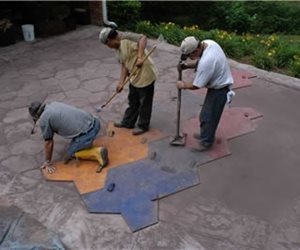How to Stamp Concrete
An overview of the concrete stamping processWhen stamping freshly poured concrete, time is of the essence. If stamped when the concrete is too soft, it won’t support the weight of workers and the texture will not be defined. If stamped when the concrete is too hard, stamping work will be difficult and the texture will not take. For this reason, it is best to hire an experienced contractor, who will be able to recognize when the concrete has reached the right stage of manipulability, to install your stamped concrete.
Concrete stamping work is typically done on new concrete. A fresh slab is formed and poured and a stamping crew comes in shortly after to add texture. The following is a step-by-step overview of the stamping process:
Apply color hardener
Color hardener colors and strengthens the surface of the concrete. It is broadcast by hand and then floated into the surface using a tool called a bull float.
This is not an essential step. If you plan to have your stamped concrete colored integrally or post-colored with concrete stains or dyes, color hardener can be skipped.Apply release agent
A release agent keeps rubber stamping mats from sticking to the concrete, think of it as the equivalent to no-stick cooking spray. Available in two forms, powder and liquid, a release should be applied just before stamping.Check concrete’s plasticity
To get the cleanest, most realistic texture, stamping should occur when the concrete is at the right stage. Most contractors test with a fingerprint or by applying one stamp and checking that it will support their weight and produces a nice result.Pretexture the edges of the slab
This step ensures that the edges will have just as much texture as the rest of the concrete. A texturing skin or flex mat is used so that it is not impeded by the edge of the form.Begin placing stamp mats
The stamping crew will place one or two rows of stamps, beginning at the portion of the slab that was poured first. The installers will stand on top of the mats to ensure that the texture is imparted. The first row must be laid straight because it starts the pattern for the entire project.Continue placing stamps
The crew will stand on the starter mats and ad more mats in another row. Sometimes the process is referred to as leapfrogging. Most contractors do not have enough stamps to cover an entire patio or driveway, so they remove stamps that have been placed and tamped to new positions to continue the pattern.Do detail or touch up work
In the case that some textures do not turn out as clean as you’d like, your contractor can take hand tools and fix joints. Blurred pattern lines or cement paste that comes up between joints can usually be fixed easily as long as the concrete is not allowed to harden.Remove residual release agent and apply curing compound
Depending on the type of release agent used, your contractor may need to wash the residual off the surface and wait a few days before applying a curing compound.Install joints
Control joints are necessary in all concrete, even stamped, to prevent random cracking. Joints can be added with a groover before the concrete sets or with a saw and diamond blade after the concrete sets.Seal the concrete
A sealer will protect your concrete from stains and other problems. In most cases, sealer is applied a few weeks after stamping so that the concrete has cured completely.
All-in-all the process of stamped concrete takes a few weeks, including sealing. However, the bulk of the work is done in just a few days (forming, pouring and stamping). Make sure to ask your contractor how long you need to wait before using your new patio, driveway or walkway, this can vary according to weather and other factors.
Depending on the size of the job and the detail required, you can expect to have anywhere from as few as three installers to more than eight working on your concrete. Typically, more installers are better, because they can work quicker and ensure they are stamping at the optimum time. You may want to ask the contractor you are considering how many people are on his crew.

 Backyards
Backyards
 Front Yards
Front Yards



